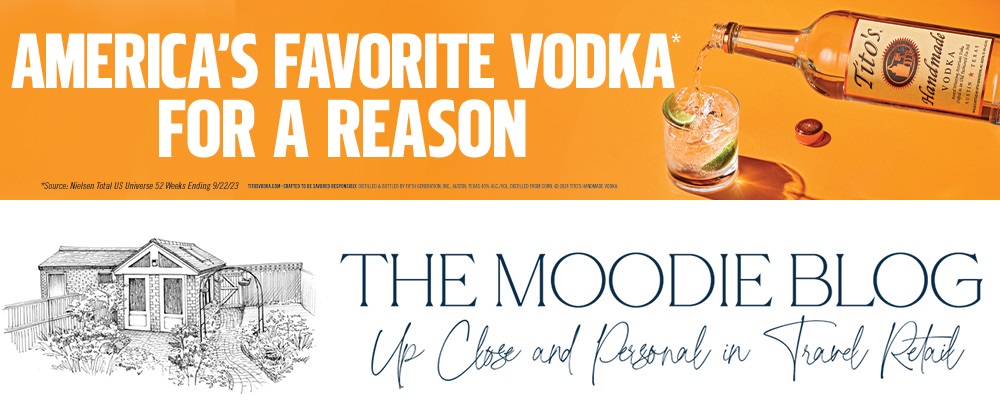Latest posts by Martin Moodie (see all)
- On the road to Mandalay where the Flying Kiwis play - December 15, 2024
- Finding a new way to shed Writers’ Tears in Galway - November 28, 2024
- A last red rose and a final farewell - November 22, 2024
Pictures often tell stories better than words. And these photos I took at Paris Charles de Gaulle Airport Terminal 2E before my flight to Hong Kong on Tuesday night do indeed tell – with a little help from me as a narrator – an intriguing tale.
As passengers exit central security at 2E, they find themselves immediately immersed within a luxury retail zone (punctuated by a busy circular seafood bar/restaurant), anchored at the front by a typically elegant and alluring Louis Vuitton store, the upscale ambience segueing into LV’s upscale peers, Dior, Chanel, Hermès, Gucci, Cartier, Celine, Bvlgari, Saint Lauren and Tiffany.
A rollcall of luxury if ever there was one.

It’s precisely 8.43pm as I take my first photo of the LV store. Over the next three hours, three flights will depart to Mainland China, two to Shanghai Pudong International Airport and one to Beijing Capital International. In pre-COVID days, that would have spelled a shopping bonanza for those storekeepers. But these are post-COVID days. More of that in a moment.
That first shot is the one above of the Louis Vuitton store, its shimmering exterior and sumptuous interior as easy on the eye as the luxury items inside are not so easy on the pocket.

It’s an external shot as you will note, partly because I know the brand does not allow in-store photos but mainly because the boutique is cordoned off. Must be busy, right? An understandable case of careful queue management and a desire to serve customers in a refined and uncrowded atmosphere.
Wrong. I peek into the store, right then left. There is one customer. A young Chinese woman sitting at the counter to the left being attended by a staff member. Two other employees are standing by inside. I gesture with my hands to one of them as if to say” “Why can’t I come in?” She looks away.
Maybe, in fact probably, I would have bought something. It was my wedding anniversary the next day, after all… if I came home empty-handed my wife might have been, to reference the LV velvet cordon, ropeable.
I said alluring earlier. But I’m not so sure that an (albeit elegantly) cordoned-off luxury store – even one bearing the most lustrous brand name on the planet – is actually that alluring. Nor that it conveys a good first impression of the airport’s shopping offer.
Others will differ. In a Sydney Morning Herald article titled ‘Right on queue: Why waiting in line is fashion’s hottest sign of success’, Professor Nitika Garg from the University of NSW School of Marketing describes the rationale for roping off stores thus: “It reflects a number of brands changing their philosophy around personalisation and customer experience by choosing to service their customer one on one.
“These brands no longer have people in the boutique unaccompanied. They want people to feel cherished and special.”
In a time-constrained airport setting I’m not so sure. Unlike a downtown boutique, there’s no staff member standing by the cordon to explain the queue. Heck, there’s not even a queue. To me it simply represents lost business and a misalignment with evolving customer sentiment.



All the other luxury boutiques are fully open for business but most are bereft of customers, anecdotal confirmation perhaps of the widely touted softness of Chinese travel shopping.






All this changes when I arrive at Relay, the Lagardère Travel Retail-owned travel essentials store, where I count almost 40 people queuing to purchase. Good (ultimately) from a retailer’s perspective, a little frustrating from a consumer’s. But the service is quick and I see no-one giving up and leaving the queue.
Think about the semantics – essentials is an important word in assessing the future of travel shopping. Earlier in the week I interviewed Lagardère Travel Retail Chairman and CEO Dag Rasmussen, a conversation that majored on the company’s ‘triple-axis’ portfolio of duty free and fashion, travel essentials and foodservice – each occupying ballpark equal weighting in revenue terms (the same could broadly be said for arch-rival Avolta).
It’s a balance that multiple Gold Medal-winning American gymnast Simone Biles would be proud of.






So much for for luxury, travel essentials and food & beverage (the elegant Ladurée macarons specialist outlet was also doing a healthy level of business), how about duty free?
The sector is run by Extime Duty Free, a joint venture between Lagardère Travel Retail and Groupe ADP. The offer is what the English might call a curate’s egg – good (in fact, very good) in parts, disappointing in others.
Writing those words prompted me to explore the derivation of the term. So, if you will permit me to digress, as is my want, here, courtesy of Collins Dictionary, is the answer.
It was spawned, as it were, from an 1895 cartoon in the sadly deceased British humour and satire magazine Punch, in which a timid curate, having been served a bad egg while breakfasting with his bishop, says that parts of the egg are excellent.

And indeed, parts of Extime Duty Free are eggcellent, sorry excellent, particularly skincare, fine wine and spirits. Never a bad egg actually, but one that leaves the impression that the various zones have been designed by different teams. Not so much a curate’s egg as a scrambled one. ✈



















You must be logged in to post a comment.